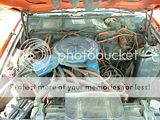I'm starting this thread to see if others can confirm, deny, or expand upon what information I've found on this subject.
The subject just came up in another post which reminded me to do this, and rather than hi-jack the PO's thread I thought this subject might deserve a heading of its own.
Okay, so what I've been able to find so far is linked below...
1)
http://www.fordification.com/tsb/viewto ... ?f=5&t=613
EDIT: Article 966, TSB #55, Group 10 Fuel System Specifications has more detailed info on the Carter YF and Autolite 1101 regarding calibrations for IMCO and Thermactor (see "Read More" button)
http://www.fordification.com/tsb/viewto ... =659&p=721
2)
http://www.mustangbarn.com/vacuum.html
http://www.mustangbarn.com/images/vacs/68%20f32.jpg
http://www.mustangbarn.com/67vacuum.html
3)
http://www.mustangsunlimited.com/itemdy ... 1=39430+01
So what I conclude from the sources and examples above is that IMCO was a ford term for 'Improved Combustion' that began in 1968 ('67 in California). There were essentially two types of ford 6cyl setups from 1968 on until the evolution of Duraspark, feedback carbs, egr, fresh air emission systems, etc.
For all 200ci models '68 and after, one system was referred to as Thermactor and the other was IMCO (but is more commonly known as 'non-Thermactor' or generically 'the setup without the emissions stuff').
From what I've been able to find, these are the only solid conclusions I've come to, and are submitted for :thumbdown: approval and critique.
:thumbdown: approval and critique.
1) IMCO included the later and larger C8 exhaust manifold with a 2" outlet (but without egr, smog pump, or other special exhaust based emissions equipment).
2) IMCO carburetors were not 'engineered' any differently than Thermactor or other carburetors of the time, but did have some small 'tuning' differences
3) IMCO may have also included the first increase in combustion chamber size from 51-53cc to 62cc
4) The MAIN significantly different component part of IMCO was the 'dual vacuum advance' 1968 distributor that utilized a spark retard hose plumbed to the canister as well as a distributor vacuum control valve coming off the intake manifold that controlled the vacuum 'retard' signal.
In general what I can find leads me to beleive that IMCO encapsulates the running changes made to all 200ci engines beginning in 1968 and the term has little component specific attributes other than the unique ignition system that soon gave way to Duraspark.
EDIT: So what do you think is this a fair assessment?
Interested in all opinions adding to, subtracting from, or even shooting holes in...
Thanks!
The subject just came up in another post which reminded me to do this, and rather than hi-jack the PO's thread I thought this subject might deserve a heading of its own.
Okay, so what I've been able to find so far is linked below...
1)
http://www.fordification.com/tsb/viewto ... ?f=5&t=613
EDIT: Article 966, TSB #55, Group 10 Fuel System Specifications has more detailed info on the Carter YF and Autolite 1101 regarding calibrations for IMCO and Thermactor (see "Read More" button)
http://www.fordification.com/tsb/viewto ... =659&p=721
2)
http://www.mustangbarn.com/vacuum.html
http://www.mustangbarn.com/images/vacs/68%20f32.jpg
http://www.mustangbarn.com/67vacuum.html
3)
http://www.mustangsunlimited.com/itemdy ... 1=39430+01
So what I conclude from the sources and examples above is that IMCO was a ford term for 'Improved Combustion' that began in 1968 ('67 in California). There were essentially two types of ford 6cyl setups from 1968 on until the evolution of Duraspark, feedback carbs, egr, fresh air emission systems, etc.
For all 200ci models '68 and after, one system was referred to as Thermactor and the other was IMCO (but is more commonly known as 'non-Thermactor' or generically 'the setup without the emissions stuff').
From what I've been able to find, these are the only solid conclusions I've come to, and are submitted for
1) IMCO included the later and larger C8 exhaust manifold with a 2" outlet (but without egr, smog pump, or other special exhaust based emissions equipment).
2) IMCO carburetors were not 'engineered' any differently than Thermactor or other carburetors of the time, but did have some small 'tuning' differences
3) IMCO may have also included the first increase in combustion chamber size from 51-53cc to 62cc
4) The MAIN significantly different component part of IMCO was the 'dual vacuum advance' 1968 distributor that utilized a spark retard hose plumbed to the canister as well as a distributor vacuum control valve coming off the intake manifold that controlled the vacuum 'retard' signal.
In general what I can find leads me to beleive that IMCO encapsulates the running changes made to all 200ci engines beginning in 1968 and the term has little component specific attributes other than the unique ignition system that soon gave way to Duraspark.
EDIT: So what do you think is this a fair assessment?
Interested in all opinions adding to, subtracting from, or even shooting holes in...
Thanks!













